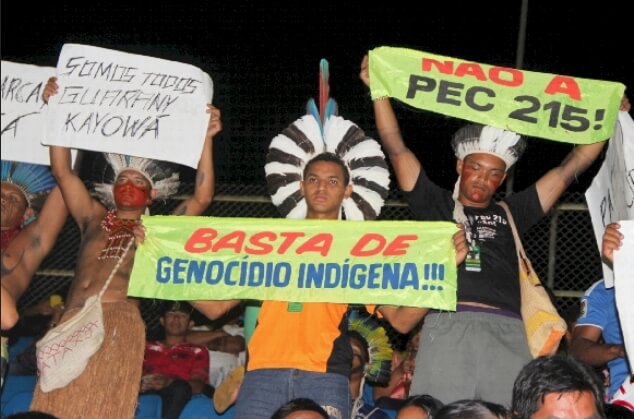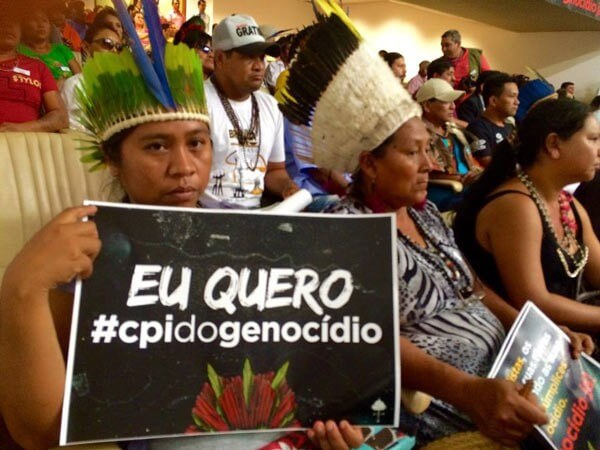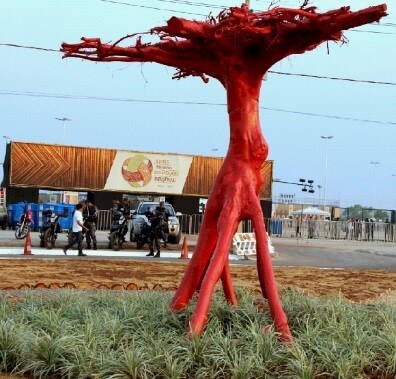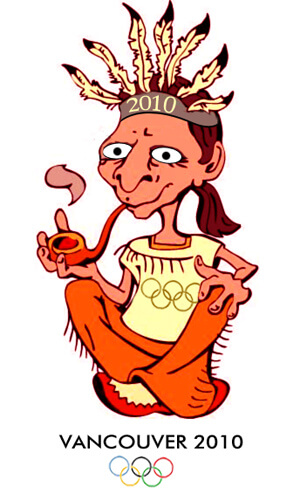
The World Indigenous Games was arguably the most hotly anticipated international event in 2015. And for good reason: It’s not every day that 2000 Indigenous men and women come together from all corners of the globe.
However, there was a side to the Games that most of us never got to see amidst the media’s constant promotion of friendly cultural exchanges, festivities and games peppered with reviews of indigenous fashion trends that have lasted thousands of years. Only occasional seconds of protests and banners reading “PEC 215 NÃO!” would fly across our screens to little affect. Very few would come to realize that Brazil approved the text of a major piece of anti-indigenous legislation while the world was busy looking stage left.
Behind the cameras, a groundswell of networks and organizations came together to issue the Palmas Manifesto condemning the opportunistic approval of PEC 215, a law that government officials repeatedly promised to send to history’s trash bin.
Even fewer would notice the demonstrations in Brasilia by Guarani Kaiowa bearing the casket of Semião Vilhalva or the Kaiowa Guarani protesting genocidal conditions in Mato Grosso do Sul.
The official Games website, projecting an air of pomp and circumstance, stood out as the statistical equivalent of a recently popularized rodeo. Relying on the international diplomacy model perfected by the Olympics, the marvelous tourism device served well to distract us from the Indigenous reality in Brazil that so dearly needed our attention.

Photo: CIMI Archives
Inside the Games, the prevalence of indigenous peoples selling crafts ended up getting taken for granted by the many non-indigenous spectators who made the trek to Palmas, Brazil. No one would raise questions about indigenous culture or history, or what it actually meant to have one’s face painted with traditional patterns for two dollars and fifty cents (US). The kind-hearted visitors would simply pay their fee, walking away with the feeling that now “We are all Indigenous”.
Despite the artful media presentations, however, one encounters cognitive dissonance in the face of documentation. The very presence of light is an invitation to present that documentation.
The event organizers would fail to take on such a task themselves. That is why, despite the opening celebration runway beauty pageant that featured indigenous women in full traditional regalia, there was no space for women to organize discussions regarding systemic failures in indigenous health services, a truly insidious vector in the current indigenous health crisis in Brazil. Nor were there opportunities to even hear the name Cacica (Chief) Eunice of the Guarani village of Itaty (Morro dos Cavalos), in Palhoça, Santa Catarina. Cacica Eunice is facing death threats for her unwavering demand that the government fully recognize already confirmed traditional lands—lands that could be redrawn thanks PEC 215.
The Games organizers equally failed to incorporate what was referred to as the Oca de Sabadoria (Longhouse of Wisdom), a public service that would provide Indigenous Peoples with web access along with practical workshops on computer literacy and social media (something that is still very new to those who don’t have electricity or internet access).
After spending more than ten years exploring risk and efficacy, entire libraries of cultural archives are now being established and shared online while training workshops for indigenous film makers are becoming increasingly diversified and refined including and beyond the model introduced by Videos nas Aldeias.
By offering to compliment this ongoing work, the Games organizers helped to legitimize themselves in the eyes of Indigenous Peoples; only to freeze up when it came time to put their words to action.
Even before the Games started, on Sept. 10, 2015, the National Secretariat of CIMI conveyed an announcement by 28 Krahô caciques to the organizers of the games (formal document number 03/2015) explaining that they decided not participate in the Games. In their letter, they demanded that “Event organizers withdraw the images and the Krahô name from any media communications that serves to promote the Indigenous World Games”. More than two months later, a promotional video featuring the Krahô remains on an official government YouTube page. By October, the Guarani Kaiowa in Mato Grosso do Sul followed the Krahô’s example, declaring that they too would refuse to participate in the Games, choosing instead to continue focusing on their struggle for land rights.
One of the few consistent presences reporting from the Games, and publisher of the annual Report on Violence Against Indigenous Peoples in Brazil for over a decade, was CIMI.
During the Games, Brazil’s agribusiness lobby (otherwise known as the ruralistas) dominated the Legislative Assembly of Mato Grosso do Sul opening a Parliamentary Commission of Inquiry (PCI) against CIMI, revealing absurd and undocumented accusations that the organization was inciting the Kaiowa Guarani efforts to occupy and have ratified their already confirmed traditional lands (which represent an estimated 3 per cent of the state’s land area).

Photo: CIMI Archives
After trying to squeeze that lemon dry, Indigenous Peoples responded by making proverbial lemonade by calling for a PCI on Genocide with an added twist to the Games popular slogan: “We are all CIMI”. The call for a PCI was backed by a spectrum of state, national and international human rights and civil society organizations. The Brazilian Anthropological Association also issued a public statement in support.
While this was happening, an intensified text of PEC 215 was approved in the Congressional Special Commission. Indigenous peoples responded by launching an international social media campaign calling for a global boycott of agricultural product imports grown on indigenous lands; a call that was backed by 83 civil organizations.

Photo: CIMI Archives
There’s more. Reports are now emerging of ongoing bulldozer activities dusting up the heat and bizarrely painted uprooted tree stumps haphazardly incorporated into local landscapes. According to CIMI, a member of the Press informed them that a decision was handed down forbidding any reporting that would tarnish the image of the Games. There were Indigenous reports of a ceiling collapse, HVAC failures in kitchen facilities resulting in emergency treatment of staff for injuries and dehydration, food preparation in precarious make-shift facilities. Frustrations with credentialing chaos was reportedly later compounded by indigenous crafts exhibitors being relegated to spreading blankets on the bare ground while air conditioned booths stood empty.
As noted in one CIMI posting: “Many complaints are related to the neglect and treatment by the prefecture of Palmas, meted out to volunteers: “We arrived here and the prefecture (which was responsible for the management of resources from the Ministry of Sports to be applied to the infrastructure, including for the volunteers) placed us in a camp in which I could not sleep (very hot, without any trees and on asphalt) and there was not even water in the bathrooms … Going without meals, yesterday we managed to have a meeting with the secretariat and they are going to give us more than one meal… They said if we wanted more than one meal we would have to work more than one shift … difficult, isn’t it”. ”
Also going unreported was a June 20 demonstration in the city of Palmas by 16,000 residents of Tocantins calling for an end to corruption, greater investments in health, education and affordable public transportation. The double meaning of the Games’ PR slogan “Now we are all Indians” would seem increasingly transparent to broader civil society.
During opening ceremonies, President Dilma Rousseff made an uncharacteristically silent and demure appearance accompanied by Minister of Agriculture Katia Abreu, awarded the 2010 title “Chainsaw Queen” and head of the Senate National Agriculture Committee. Both President Rousseff and Minister Abreu vanished immediately after the ceremonies came to a close. In retrospect, that might deserve some consideration.
PEC 215 was approved by Special Commission while most of us were busy playing, watching and slaving away half starved for the games. Fortunately, the surprise approval of PEC 215 received a swift response with the Palmas Manifesto.
The Manifesto reads in part:
With the approval of 215, the anti-indigenous parliamentarians intend to not only prevent the demarcation of indigenous lands, but to also redefine the lands already confirmed and open them to exploitation of the latifundio (powers of the large landed estates) and agribusiness. In other words, this is to prevent the indigenous peoples from having the assurance of their territories and their life projects, their culture and their differentiated societies. That is, it is cultural death by decree (ethnocide) and physical (genocide) of indigenous peoples.
We view with extreme concern the advancing of the new agricultural frontier encompassing 73 million hectares in the Cerrado biome, including the states of Maranhão, Tocantins, Piauí and Bahia, called Matopiba. This mega agribusiness project will have an enormous destructive impact on the environment and thousands of traditional communities and indigenous peoples, because within the Matopiba area there are 28 indigenous lands, 34 quilombolas, 865 settlements and 42 environmental conservation units.
In this time of extremely serious threats to the lives and the rights of indigenous peoples of Brazil, we renew our hope that the projects of death, such as PEC 215 shall not prevail. We trust in the power of mobilization of peoples and society in this humanitarian cause that surpasses and breaks through all boundaries.
Indigenous concerns, just in Tocantins alone are sharpened by the Lava Jato scandal, PEC 215 and the advance of the MATOPIBA agribusiness expansion. The US government’s default support for PEC 215 might be said to have an unmistakable connection to the institutionalized premises of terra nullius and res nullius implicit in USDA commodities intelligence. MOPIC – Mobilization of Indigenous Peoples of the Cerrado, was formed by the Xavante and Krahó peoples in 2005 in response to the already intense threat of socioenvironmental degradation in the region. Since then, and in no small way due to the tireless work of MOPIC countering the bludgeons of predatory capital, broad societal recognition of the necessity for solidarity continues to emerge. But you’d never know it by looking at the news.
The issue of translation and the amount of attention that was given to actual communication between people, was another problem for the World Indigenous Games. Within both contexts we find the use and abuse of semantic imagery, timing and strategies used to suppress reality at the expense of those who must endure Brazil’s harsh political climate: the Indigenous Peoples of Brazil.
One must wonder was Carlos Terena must be thinking. Fundacao Nacional do Indio’s (FUNAI) director of Cultural Affairs, one of Terena’s lifelong dreams was bring together all indigenous peoples to celebrate the elegance and diversity of their respective cultures.
In Brazil, that dream had no choice but to stand a the side of a road that leads back to the clarion call of assimilation first articulated by the military dictatorship (1960s-1980s), in which there were to be “no more indians” by the year 2000.
Brazil, now driven by ‘growth-at-any-cost’ policies, undoubtedly saw the World Indigenous Games as a quick and easy way to advance this insidious “dream” that invariably turned Terena’s hope into a spectacle that a politically-centrist media was more than happy to endorse.
As the World Indigenous Games came to a close in Palmas, a council of international indigenous leaders announced that Canada would serve as the site for the next iteration of the Games in 2017.
A long time ally of Brazil, Canada is no stranger to international sporting events and the controversies that so often come with them.
Despite being marketed as the most socially-responsible Games in the long and sordid history of the Olympics, the 2010 Winter Olympics in Vancouver played out much like the recent Indigenous Games in Palmas.

Two years after International Olympic Committee president Jacques Rogge announced that Vancouver would host the Winter Games, an emaciated “Indian” wearing a dollar store headdress made brief headlines as the new Winter Olympics Mascot. The offensive image was ultimately replaced with a traditional cultural artifact known as an Inukshuk, leading many to charge that the Games were now trying to noveletize Indigenous culture for the sake of entertainment.
In the years that followed, the BC government would go on to invest billions of dollars in new infrastructure for the Games, leading to major cuts to social services, healthcare, education and housing. In similar stride to the “pacification process” that Brazil carried out for the 2014 Fifa World Cup, the City of Vancouver instituted policies aimed at “cleaning up” the city, leading to a 78 per cent increase in homelessness in just three years.
With Vancouver sitting on unceded Coast Salish Territory, a movement also emerged to bring the Games to a grinding halts— “No Olympics on Stolen Native Land” becoming a rallying cry for indigenous and non-indigenous solidarity activists alike. In June 2014, the Vancouver City Council would officially acknowledge that the city is on unceded lands; but while the Olympics were taking place, they were far more concerned about protecting the Utopian image they so heavily invested in.
Canada’s parliament helped to ensure the safety of that image by granting CSIS, Canada’s top spy agency, “extraordinary powers to intrude on the privacy of individuals”, according to a 2009 letter by Am Johal, chair of the Olympic watchdog group known as the Impact on Communities Coalition (ICC). Throughout the 2010 Winter Olympics, several activists would report encountering CSIS agents at their homes and workplaces, manufacturing a climate of suspicion and fear on behalf of the Games. While it didn’t stop anyone from organizing protests and calling attention to the long list of still-unresolved human rights grievances in Canada, including the conspicuously high rate of murdered and missing indigenous women in Canada, there was no space for genuine discussion or reflection throughout the 2010 Olympics.
It remains to be seen whether or not we can expect more of the same during the Second World Indigenous Games in Canada in 2017. With the amount of political growth that we have seen in Canada over the past few years, however, we can be reasonably certain that further injustices will not be taken sitting down.
Correction
A previous version of this article stated that Brazil enacted PEC 2015 when in fact it only approved the text of the document.

Indigenous Peoples are putting their bodies on the line and it's our responsibility to make sure you know why. That takes time, expertise and resources - and we're up against a constant tide of misinformation and distorted coverage. By supporting IC you're empowering the kind of journalism we need, at the moment we need it most.